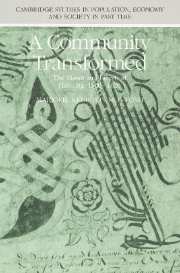Book contents
- Frontmatter
- Contents
- List of figures
- List of tables
- Acknowledgements
- Abbreviations
- Introduction
- 1 Life and death
- 2 Changing economic patterns
- 3 Religion
- 4 Facets of a society in transition
- 5 Havering's declining independence
- 6 Overt conflict, 1607–19
- Conclusion
- Appendices
- A Minimum numbers of Havering crafts- and tradespeople, 1460–1619
- B Officers of the manor, Liberty, and park of Havering, 1500–1620
- C Corrected parish register figures, Romford, 1562–1619
- D Corrected parish register figures, Hornchurch, 1576–1619
- E Clergymen within the parishes of Hornchurch and Romford, 1500–1620
- F Havering wills, 1500–1619
- G Surviving Havering manor court rolls, 1500–1620
- H Obtaining confirmation of Havering's expanded charter, 1588
- Bibliography
- Index
- Cambridge Studies in Population, Economy and Society in Past Time
H - Obtaining confirmation of Havering's expanded charter, 1588
Published online by Cambridge University Press: 11 October 2009
- Frontmatter
- Contents
- List of figures
- List of tables
- Acknowledgements
- Abbreviations
- Introduction
- 1 Life and death
- 2 Changing economic patterns
- 3 Religion
- 4 Facets of a society in transition
- 5 Havering's declining independence
- 6 Overt conflict, 1607–19
- Conclusion
- Appendices
- A Minimum numbers of Havering crafts- and tradespeople, 1460–1619
- B Officers of the manor, Liberty, and park of Havering, 1500–1620
- C Corrected parish register figures, Romford, 1562–1619
- D Corrected parish register figures, Hornchurch, 1576–1619
- E Clergymen within the parishes of Hornchurch and Romford, 1500–1620
- F Havering wills, 1500–1619
- G Surviving Havering manor court rolls, 1500–1620
- H Obtaining confirmation of Havering's expanded charter, 1588
- Bibliography
- Index
- Cambridge Studies in Population, Economy and Society in Past Time
Summary
A fortunate preservation of records enables us to watch the process through which the draft charter of 1588 moved before gaining royal approval. We can also note some additional privileges which Havering hoped to obtain but which the Queen's Solicitor General refused to approve. Thomas Legatt drew up a draft of the charter early in 1588, restating Havering's earlier rights and requesting new ones. He also prepared a short petition to the Queen, asking her favour in the confirmation and expansion of the charter. The petition begins by reminding Elizabeth that Havering is ‘parcel of the ancient demesnes of your Majesty's imperial crown of England and also the ancient nursery of many princes of this realm’. The petition was accompanied by a summary of the provisions of the attached draft, a short statement which mentions only the right to be incorporated so as to hold lands for the hospital and freedom from purveyance. The petition requests these grants so that ‘the said tenants and inhabitants shall be the better able to serve her highness at all times when they shall be thereunto commanded, and especially at such times as it shall stand with her Majesty's pleasure to have access unto your said manor’. This petition accomplished its desired purpose, for on the back of the sheet a note was written: ‘Her Majesty is pleased to grant the request above mentioned’, signed by Francis Walsingham, then Secretary.
- Type
- Chapter
- Information
- A Community TransformedThe Manor and Liberty of Havering-atte-Bower 1500–1620, pp. 444 - 446Publisher: Cambridge University PressPrint publication year: 1991

